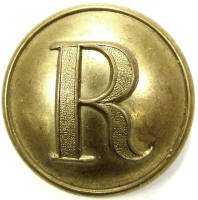
A virtual examination of artifacts of the American Civil War
by Harry Ridgeway
 |
Ridgeway Civil War Research Center, A virtual examination of artifacts of the American Civil War |
| Civil War Artillery | |
by Harry Ridgeway |
| Rifled artillery projectile, Dyer design, Federal manufacture, bursting shell, pointed nose, lead cup sabot, wood time fuze, rifled 42 pounder gun 7in. Projectile was manufactured in the Federal arsenals following the invention of Alexander Dyer. The sabot system utilized was an expanding lead cup around the base. This pattern features a massive lead sabot with a concave bottom, nose of the shell is pointed. This shell is "common", (standard), explosive charge only without lead balls, with a time fuze, shell could be used against enemy cannon or troops defending a fort. The massive lead sabot was problematic, it tended to foul the cannons, and often it would block passage of the flame to the paper time fuze. To remedy this, the sabots on some were chopped with an axe, this to clear a flame path to the fuze. Fuze employed was a wood time fuze, Jones Fuzes pg. 2. Projectile measures: diameter 6.9in., length 13.75in., weight approx. 80lbs. with sabot, 65lbs. without sabot. Most of these 7in. Dyers were used by the Federal gunboats in the assault of Island No 10, a Confederate stronghold in the middle of the Mississippi River, the island washed away years ago by the river and these shells are found in the flood plain having sailed well past the target. Research Center: Artillery4031-Dyer, Ref: Bell, Heavy Ordnance, pg. 224. Details click: http://relicman.com/artillery/Artillery4031-Dyer.html. |
| Ridgeway Civil War Research Center, A virtual examination of artifacts of the American Civil War. Artillery Research center, artillery, click: http://relicman.com/artillery/Artillery0000-Index.html. Research center, artillery, click: http://relicman.com/artillery/Artillery0000-Index.html. |
| Civil War Relicman, Harry Ridgeway, Civil War artillery, Relicman sales catalog. Click here: http://relicman.com/artillery/RelicmanSalesArtillery1.html. Artillery for sale: http://relicman.com/artillery/RelicmanSalesArtillery1.html. |